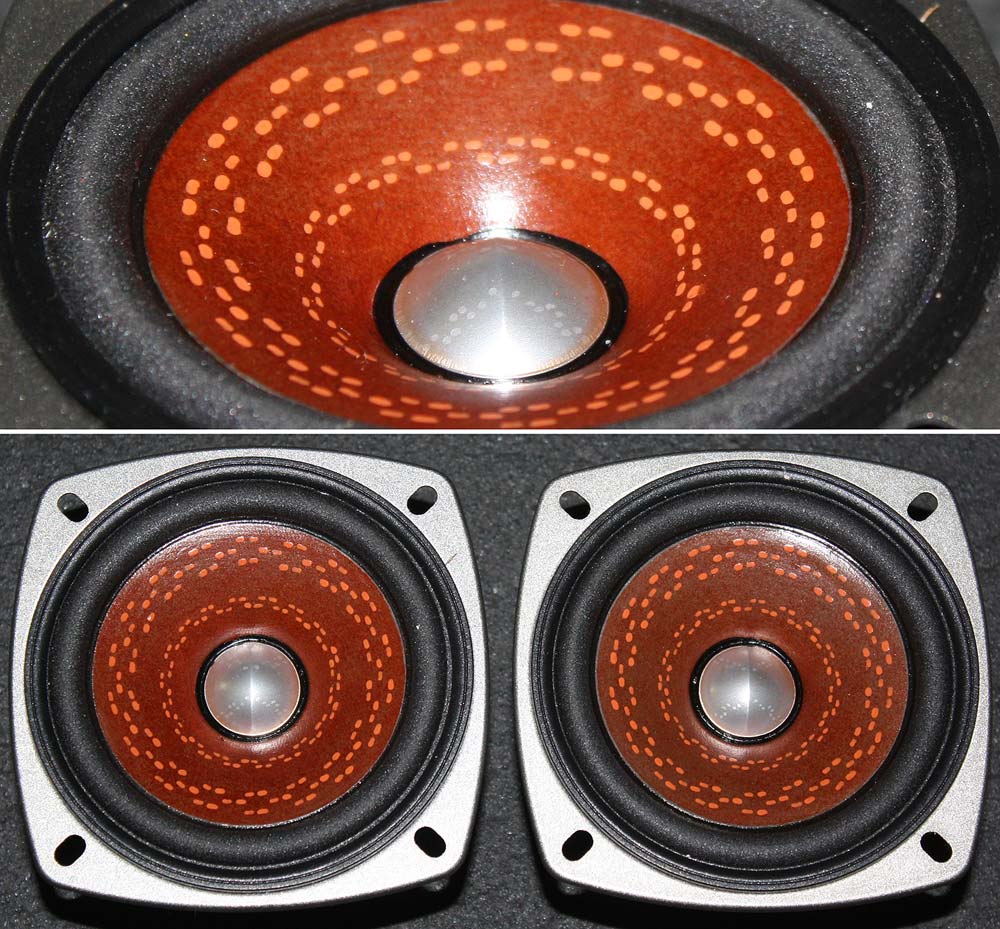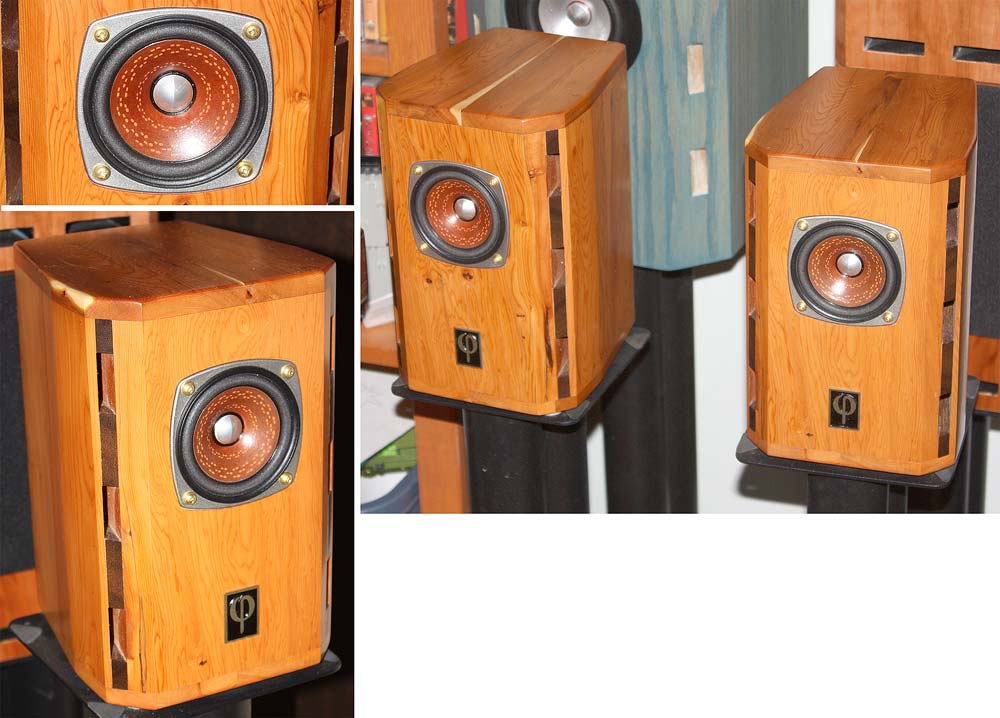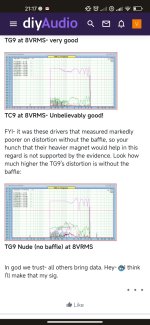Hi guys,
I am going to go three way full active on the car, and I try to find the most suitable small midrange driver.
It will be installed on the pillars to a 3d printed pod.
I know that probably the best for that size will be scanspeak 10f but it costs more than the double than the aforementioned.
So I finally am between those two.
Seas mu10 (doesn't measure so well according to the Timothy feleppa's plots)
And
Vifa ne85w
Similar price
Similar sensitivity
Another driver that I have in mind is the faital pro 3fe32, similar specs but better sensitivity and better price.
I am going to go three way full active on the car, and I try to find the most suitable small midrange driver.
It will be installed on the pillars to a 3d printed pod.
I know that probably the best for that size will be scanspeak 10f but it costs more than the double than the aforementioned.
So I finally am between those two.
Seas mu10 (doesn't measure so well according to the Timothy feleppa's plots)
And
Vifa ne85w
Similar price
Similar sensitivity
Another driver that I have in mind is the faital pro 3fe32, similar specs but better sensitivity and better price.
What about the Peerless TC9FD18? That one has alot of cred and its better than the other 2 you mentioned.
According to this testing I was quickly get the tc9 out of the equation
https://www.justdiyit.com/grand-comparatif-medium-et-large-bande-partie-2/4/
https://www.justdiyit.com/grand-comparatif-medium-et-large-bande-partie-2/4/
I saw the thread with the blind test of many broadband but probably the site has switched to another skin or something and the links of the results are not correct anymore.
I don't agree with that test. I will say in the real world, the TC9 is a very musical and honest sounding driver that can hang with much more expensive wide band drivers. As a dedicated midrange it can't be faulted. Let's face it, you can look at test results and secs all day, but what matters is the music that comes from this amazing little driver. I've heard some very expensive drivers and speakers in my day and the TC9 is in my top 10 list regardless of price.According to this testing I was quickly get the tc9 out of the equation
https://www.justdiyit.com/grand-comparatif-medium-et-large-bande-partie-2/4/
Crossover point it depends, you know the pod box volume will be limited so probably something like 500 Hz or so.
Tweeter will probably be the bliesma t25a with sensitivity around 91 db but will be full active with dsp.
Tweeter will probably be the bliesma t25a with sensitivity around 91 db but will be full active with dsp.
What about the Peerless TC9FD18? That one has alot of cred
No cred with me, the 4 i had sucked. The TG9 is way better for little more. Don’t know about the MU10 but the VIFA is good.
dave
They have very low to no DDR. The are flat and listless with no detail.
Should make for a good TV speaker where losing the low level stuff is probably a good thing.
dave
Should make for a good TV speaker where losing the low level stuff is probably a good thing.
dave
The Peerless TG9 is NLA. Can't find anyone who carries it in small quantities. Another driver gone thanks to Peerless.
Hmmm, it has low enough Rms to be decent in that regard. Im pretty picky about that sort of thing and don't share the same opinion. I also listened to the TG9s and feel they aren't much better than the TC9s. If anything, they have a more vague upper mid resolution. I would still run a tweeter with both of them. I don't enjoy a laser pinpoint sweet spot of most FR. My Mangers are wider up top than both the Peerless.They have very low to no DDR. The are flat and listless with no detail.
Should make for a good TV speaker where losing the low level stuff is probably a good thing.
dave
Well any small driver is going to suffer from a lack of baffle area. Thats usually solved with EQ. All of the small car audio drivers I've used needed some form of EQ to even them out.
Rms to be decent in that regard
Tells you nothing about the DDR.
dave
Well it is one of the deciding parameters that indicate a driver with good low level resolution, along with Qms, Le, Kmr.
I understand everyone's perspective is subjective, but I'm going on recollections I have of other small drivers of this type.
What cheaper fostex would you think is a step above the TC9?
I understand everyone's perspective is subjective, but I'm going on recollections I have of other small drivers of this type.
What cheaper fostex would you think is a step above the TC9?
@vassilis1984 - Where are you able to find the small NE series Peerless? The NE65 is a nice driver, but the alu cone is a little rough up top. The NE85 is a bit more of a midrange. I wouldn't run it FR because of the cone breakup.
The FF85wk, there are a few easy tweaks to ameriolate the few issues it has. Alpair 5.2/3 similarily priced. FaitalPro 3FE once tweaked almost as good at a lower price. The full range version of the 10F (as opposed to the more commonly talked about one) is also good but at a significant price premium. It trades a bit of smoothness for DDR. Note that the one si use are fully modified (dating from when i could see well enuff — i’ll happily help anyone wanting to diy). My personal pair.


Which brings up… the TC9 is likely as smooth and opaque as it is because it is heavily damped, too heavily for hifi.
As to the numbers… a loudspeaker is such a balancing of compromises that focusing on a single parameter to guess how a driver performs is foolish. I followed the trhead on Qms and it is baffling why one would think high is good. Best is when it is just right. Personally i prefer lower Qms, makes it easier to flatten the impedance.
Le is the inductor in series with the VC resistance. It is a low pass filter, the smaller it is the greater the potential for good HF extension. And the methods most commnly use also linearize the magnetic field.
dave


Which brings up… the TC9 is likely as smooth and opaque as it is because it is heavily damped, too heavily for hifi.
As to the numbers… a loudspeaker is such a balancing of compromises that focusing on a single parameter to guess how a driver performs is foolish. I followed the trhead on Qms and it is baffling why one would think high is good. Best is when it is just right. Personally i prefer lower Qms, makes it easier to flatten the impedance.
Le is the inductor in series with the VC resistance. It is a low pass filter, the smaller it is the greater the potential for good HF extension. And the methods most commnly use also linearize the magnetic field.
dave
I understand what you're saying. Qms shouldn't be too high. I usually gravitate towards a higher Qms, but less than 10. It depends on the cone material and I always prefer paper cones with very few exceptions. Low Rms on a high efficiency driver is important, not so much on a mid to high 80s dB/W. Of course none of these numbers corelate to cone breakup behavior, which is what matters most on a FR driver.
That FF85WK is a unicorn and has a certain charm to it that other fostex drivers don't have. I use some older Auratones most of the time when I'm doing nearfield editing work, mainly becuase I know very well how they translate a mix into the modern world of personal mid-fi audio. The old CTS driver version is pretty good, but obviously not very extended up top. Nonetheless you can hear certain things much better in the mids with it that you can't with a typical 2 way monitor, especially in mono. The Manger MSW is even better at revealing midrange nuances, but too big for the smaller desk space i have.
For car audio a paper cone driver is risky because of how the cone has to deal with moisture and temperature swings. For that application I'd always try to use a driver with a synthetic cone, even though I don't prefer the sound signature it has. I quit the car audio scene due to the noisy environment you have to combat. Nowadays in modern cars you're often stuck with the integration of the oem audio to the cars central functions, so modifying the audio itself is much more difficult.
That FF85WK is a unicorn and has a certain charm to it that other fostex drivers don't have. I use some older Auratones most of the time when I'm doing nearfield editing work, mainly becuase I know very well how they translate a mix into the modern world of personal mid-fi audio. The old CTS driver version is pretty good, but obviously not very extended up top. Nonetheless you can hear certain things much better in the mids with it that you can't with a typical 2 way monitor, especially in mono. The Manger MSW is even better at revealing midrange nuances, but too big for the smaller desk space i have.
For car audio a paper cone driver is risky because of how the cone has to deal with moisture and temperature swings. For that application I'd always try to use a driver with a synthetic cone, even though I don't prefer the sound signature it has. I quit the car audio scene due to the noisy environment you have to combat. Nowadays in modern cars you're often stuck with the integration of the oem audio to the cars central functions, so modifying the audio itself is much more difficult.
- Home
- Loudspeakers
- Multi-Way
- VIFA NE85W vs SEAS MU10
